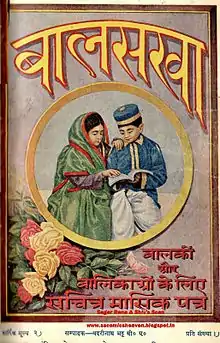Balsakha
Balsakha[1][2][3] was one of the most popular children magazines in Hindi. In the year 1917, the Indian Press Prayag started publication of Balasakha magazine. This magazine was the most popular of its time. Balsakha was published for more than 53 years and this magazine influenced the child readers and prepared a good number of child writers also.
 Photograph of cover page of magazine Balsakha | |
| Former editors | Pandit Badrinath Bhatt,Devidutt Shukl, Thakur Srinath Singh |
|---|---|
| Categories | Indian children's magazines |
| Frequency | Monthly |
| Publisher | Indian Press Limited Prayag |
| Founder | Chintamani Ghosh |
| Year founded | 1917 |
| Language | Hindi |
History and profile
Balsakha was first published in 1917[4] by Chintamani Ghosh,[5] the founder of Indian Press Prayag (Allahabad).He also published saraswati (magazine). The first editor of Balsakha was Pandit Badrinath Bhatt and later on Thakur Srinath Singh edited the magazine for many years.[6][7] It was published on a monthly basis.[4]
Balsakha is still remembered in Hindi children's literature.[8] Balsakha was published monthly for more than 50 years.[9] Many distinct and famous personalities of that era had contributed their work towards children literature in Balsakha.[10] Balsakha was also subscribed by library of various states and juvenile jail of then British India.[11][12] For publishing the life character of various national leaders, the Punjab Text Book Committee of pre-independent India stopped subscribing Balsakha.[13] Publisher and editors of Balsakha and other contemporary magazines assumed children as an independent unit and carried on their work towards children literature. The literary work of these editors was focused on childhood. That is why Balsakha remained popular with children for a long time.[14]
References
- Jamunā, Ke E.; Division, India Ministry of Information and Broadcasting Publications (1982). Children's literature in Indian languages. Publications Division, Ministry of Information and Broadcasting, Govt. of India. pp. 65, 66, 81. Retrieved 4 June 2016.
- Kumar, Krishna (2005). Political agenda of education : a study of colonialist and nationalist ideas (2nd ed.). Thousand Oaks, Calif.: SAGE Publ. p. 146. ISBN 978-0-7619-3316-8.
- "Children's Literature In Hindi". Goodbooks.in. Archived from the original on 23 April 2016. Retrieved 21 April 2016.
- Krishna Kumar (12 August 2015). Politics of Education in Colonial India. Taylor & Francis. p. 154. ISBN 978-1-317-32562-8. Retrieved 16 October 2016.
- "'प्रकाशन में बाबू चिंतामणि ने दिया अविस्मरणीय योगदान' 12716123". jagran. Retrieved 21 April 2016.
- The Book Review. C. Chari for Perspective Publications. 2005. Retrieved 18 June 2016.
- Data India. Press Institute of India. 1996. Retrieved 18 June 2016.
- Chandra, Nandini (1 August 2007). "The Pedagogic Imperative of Travel Writing in the Hindi World: Children's Periodicals (1920–1950)". South Asia: Journal of South Asian Studies. 30 (2): 293–325. doi:10.1080/00856400701499250. ISSN 0085-6401.
- Kumar, Krishna (2015-08-12). Politics of Education in Colonial India. Routledge. ISBN 9781317325628. Retrieved 21 April 2016.
- Birla, K.K. (1994). Partner In Progress Selected Speechs And Writings Of K.k.birla. New Delhi: Hindustan Times. pp. 5, 7. Retrieved 28 August 2016.
- Annual-Report-On-The-Administration-Of-The-Shahpura-State (PDF). p. 19. Archived from the original (PDF) on 12 November 2016. Retrieved 12 November 2016.
- Mental-Health-Series-No-I-Psychiatric-Approach-To-Institutional-Treatment-Of-Delinquency (PDF). p. 18. Archived from the original (PDF) on 12 November 2016. Retrieved 12 November 2016.
- "saraswati.pdf". Google Docs. Retrieved 12 November 2016.
- Kumar, Prof.Krishn. "shiksha vimarsh(JUL-DEC 2005)". Google Docs. Digantar Shiksha avam Khel Kood Samiti. Retrieved 14 January 2017.